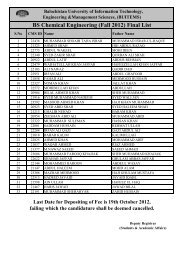BUITEMS
Research Journal - buitems
Research Journal - buitems
- No tags were found...
You also want an ePaper? Increase the reach of your titles
YUMPU automatically turns print PDFs into web optimized ePapers that Google loves.
<strong>BUITEMS</strong><br />
Quality & Excellence in Education<br />
Rational Design of Retaining Walls<br />
P<br />
opt<br />
=<br />
1<br />
2aN<br />
i=<br />
1<br />
3<br />
bN<br />
[ i ] [ 5 - ( i -1) 4 ( 1) ]<br />
5 + i -<br />
4 3<br />
N<br />
2<br />
4<br />
3L<br />
i -<br />
2<br />
i=<br />
1 ( EI )<br />
i<br />
5L<br />
2L<br />
N<br />
4<br />
2N<br />
1<br />
( EI<br />
[ i<br />
3 - ( i -1) ]<br />
3<br />
)<br />
In the particular case q 1 =q 2 =q, а N=1. P<br />
i<br />
opt<br />
(3.6)<br />
= 0,375 qL , (3.7)<br />
which coincides with the result, obtained in [5]. Since the system is statically indeterminate to the first degree<br />
P = + , (3.8)<br />
P P<br />
opt f ps<br />
Where P f – selftensile force,<br />
P ps – pre-tensioning force.<br />
P = P - P , (3.9)<br />
Hence, the required value of pre-tensioning force of anchor is equal to<br />
ps opt f<br />
selftensile force defined by force method<br />
D 1p<br />
P<br />
f<br />
= - , (3.10)<br />
d<br />
d<br />
L<br />
11<br />
3 N<br />
= 11 3<br />
3N<br />
i= 1<br />
1<br />
( EI )<br />
i<br />
2<br />
(3i - 3 i + 1)<br />
5<br />
5 Nb 4<br />
4<br />
[ i - ( i -1)<br />
] + [ i - ( i -1)<br />
]<br />
5<br />
L<br />
N 1 a<br />
D<br />
1p<br />
= -<br />
.<br />
5<br />
N i=<br />
1 (EI ) i 5<br />
4L<br />
The primary structure of force method and moment diagrams are shown in Figure 3.1. Finally<br />
N<br />
1 a<br />
[ bN<br />
i<br />
5 - ( i -1) ] [ 5 + i<br />
4 - ( i -1) ]<br />
4<br />
3L<br />
2 i=<br />
1 ( EI )<br />
i<br />
5 4 L<br />
Pf =<br />
2<br />
N<br />
1<br />
( ( ) 3 2<br />
i - 3 i + 1)<br />
(3.11)<br />
N<br />
i=<br />
1 EI<br />
i<br />
Comparing the expressions (3.6) and (3.11) can be noted that P<br />
opt<br />
= Pf<br />
, (3.12)<br />
and as result P = 0 ps ;<br />
This result is very interesting and shows that in the case of condition (3.1) pre-tension of anchor is not required.<br />
The general solution is an iterative procedure consisting of two cycles. The external cycle implements a consistent<br />
change in the force of pre-tensioning of anchor until performance of condition:<br />
P m m-1<br />
- P £ e , (3.13)<br />
ps<br />
ps<br />
where m - number of external iteration, ε - given accuracy.<br />
As initial approximation, is taken distribution of heights of wall sections, which found for cantilever system by<br />
(1.19) (1.20). Further, the internal iteration cycle is executed, generated by (1.10) (1.19) (1.20). The analysis of<br />
system was done by using PC "LIRA". The results of formation of geometry of wall by (1.10) are shown in Fig. 3.2<br />
3.2. Dependence "height wall of section - height of<br />
wall," as defined by (3.10) in the wall with anchor: eu -<br />
ultimate SED, e - actual SED.<br />
3.3. Dependence "SED per unit length - height of wall,"<br />
as defined by (3.10) in the wall with anchor: e u -<br />
ultimate SED, e - actual SED.<br />
As seen from the graphs, the anchor reduces the height of section of equally strength wall by 41.5%, and changes,<br />
the qualitative nature of its height.<br />
115
















